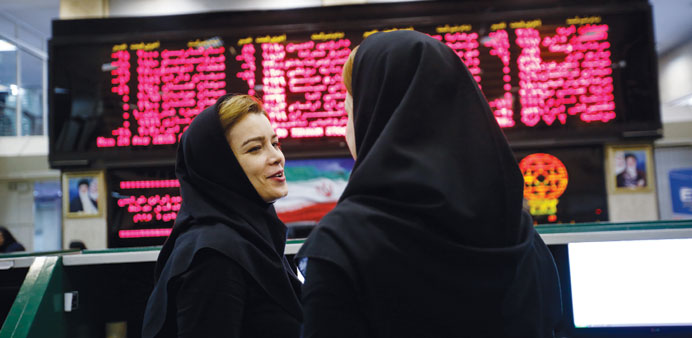Women employees talk beneath electronic screens displaying financial data at the Tehran Stock Exchange (file). After moderate cleric Hassan Rouhani was elected president in June 2013, the Tehran Stock Exchange’s benchmark index doubled, hitting a record of 89,500 within seven months. The index has since dropped about 30%, hurt in part by falling crude oil and commodity prices.
Bloomberg
Tehran
An increasing number of international investors are preparing to trade Iranian stocks once economic sanctions are lifted, according to the head of the bourse in Tehran.
“We had a lot of requests and a lot of visitors from abroad,” said Hassan Ghalibaf Asl, the chief executive officer of the Tehran Stock Exchange, in a recent interview at his office in the Iranian capital. Some 50 international investors received approval to trade on the exchange in the past six months, and are now awaiting the end of sanctions, he said.
Iran and six countries, including the US, ended a 12-year standoff in July by signing an agreement limiting Iran’s nuclear programme in exchange for the removal of trade and other restrictions. Under the accord, Iran will be freed from economic and financial sanctions once UN monitors verify it has curbed its nuclear activities and addressed suspicions that it sought to develop atomic weapons in the past. That could happen by early 2016.
Relief from sanctions may accelerate economic growth in the nation of 77mn people by removing barriers to Iran’s oil exports and ending the isolation of its banks from the global financial system. Charlemagne Capital Ltd is among international investors that has said the opening of the Iranian market is too big an opportunity to miss. It said in April it was working with a firm in Tehran to start a sanctions-compliant fund.
“It’s very rare to find an early-stage market with all this infrastructure that’s very well developed locally,” Dominic Bokor-Ingram, a portfolio adviser at Charlemagne Capital, said by phone from London. “It’s also a very diversified economy, probably one of the most diversified in the world.”
Iranian stocks have swung over the past two years as the prospects for an agreement fluctuated. After moderate cleric Hassan Rouhani was elected president in June 2013, the Tehran Stock Exchange’s benchmark index doubled, hitting a record of 89,500 within seven months. The index has since dropped about 30%, hurt in part by falling crude oil and commodity prices.
The more than 300 companies on the Tehran exchange have a combined market capitalisation of about $91bn. There are 37 industry groups, with major companies in segments ranging from petrochemicals to banking to autos, cement and telecommunications.
Established in 1967, the Tehran exchange has grown significantly since 2006, when the government of Mahmoud Ahmadinejad oversaw a period of privatisation of state-owned companies. Since 2010, foreigners have also been allowed to invest.
The exchange can accommodate “considerable foreign investors” because it’s so diversified, Ghalibaf Asl said. In all, about 360 international investors have sought permission to trade on the exchange since it opened to foreign firms, he said, adding that because of the sanctions, “the portion of the foreign investors in our markets is very low.”
That may be about to change.
“I know of funds that have already been established to put money in Iran and that are already attracting investor interest,” Charles Robertson, chief economist at Renaissance Capital, said by phone before boarding a plane to Tehran. “The only exaggeration comes from thinking that it’s going to make them fortunes overnight, but I haven’t seen anyone suggest that’s the case. Inevitably, there will be some disappointment along the way.”



